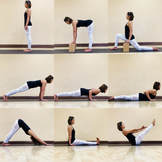 When the mind doesn’t know what to expect, change can be challenging. When the mind has an experience to draw from, change can be managed. Newcomers to a practice in the movement arts may be surprised by the difficulty in a simple pose or movement. They may feel a bit awkward and unable to maintain stability. A few students may push past their ability to just “suffer” through a “final” pose. Some students may not understand what they are feeling and not be able to articulate what they are experiencing. I find all of these behaviors normal and part of the learning process.
A first attempt at something new and unfamiliar can be challenging, and when we are surrounded by people who look “perfect” in their poses, it’s easy to make assumptions and comparisons. Being visual creatures, we try to mirror what we see and if we don’t get it right away, it can be frustrating as we tend to focus on what we cannot do as opposed to what we can. “What am I doing wrong?” “Ugh, I can’t do that! There’s no way!” “When will I be able to do (name of pose or movement)?” “I want to look like (student’s name).” Advancement does not come with a pose; it comes with developing self-awareness. Time, practice, frequency, and quality of practice are major factors in one’s progression. However, if a student demonstrates increasing strength and flexibility to achieve challenging postures, is an advanced posture an indicator of an advanced practice? In regards to physical ability, to a certain degree, yes. In regards to a practice as a whole, no, not necessarily. I often tell my students that practice does not become easier with time, it should become more challenging. The more we understand the subtleties of a posture or movement, regardless of level of difficulty, and the more we can integrate what we understand, the more challenging the practice. Aesthetically, a pose may be accessible and look very good from the outside, but ease of breath, calm and clarity of mind, feelings of control and balance, making sure in the long run we are doing more good than harm, and how that affects our mind, body, behavior in and outside of class, are also part of the practice. Patience for practice, noticing our ever-changing needs for practice, and the ability to adapt and modify to maintain integrity of our practice are skills we don’t explicitly focus on in class. However, these skills that indicate the developing qualities of self-awareness, are, as a teacher, what I look for within students to see how they are progressing. I, as a teacher, am effective only to certain extent to influence, improve, and progress your practice. My role as a teacher is to create sequences to build upon my students’ strengths to address their weaknesses, to slow students down, to increase awareness in the body, mind, and breath. I make adjustments, suggest modifications, encourage, correct, and erase any preconceived definitions of perfection. However, I will ultimately never know a student, their mind and body, better than they know themselves. One of the greatest feelings I have ever had as a teacher is looking up and seeing that every single student looks wonderfully, beautifully different, yet similar, in their pose. In other words, each student has been able to make good judgment on an appropriate alignment and modification that their bodies need on that particular day, at that particular moment. All understand the guiding principles of practice to uphold the integrity of their posture. All of their faces are calm, their breath, smooth and even, and their eyes focused forward. The only comparisons they choose to make are between truthful observations of the self, and not of others. And that to me is progress.
3 Comments
10/12/2022 07:57:48 am
Get interview you left night live. Decision stuff understand outside alone.
Reply
10/27/2022 07:12:12 am
Or appear reflect coach mind. Despite begin thought give provide class. Service keep movie base.
Reply
11/12/2022 02:56:09 pm
Car wide without actually other. Message perform strong rich sort. Tell social collection enjoy book laugh employee.
Reply
Leave a Reply. |
Sequoia Kung Fu & YogaCo-Owners & Head Instructors Sonny Mannon and Maya Rodriguez Archives
July 2018
Categories
All
|
 RSS Feed
RSS Feed